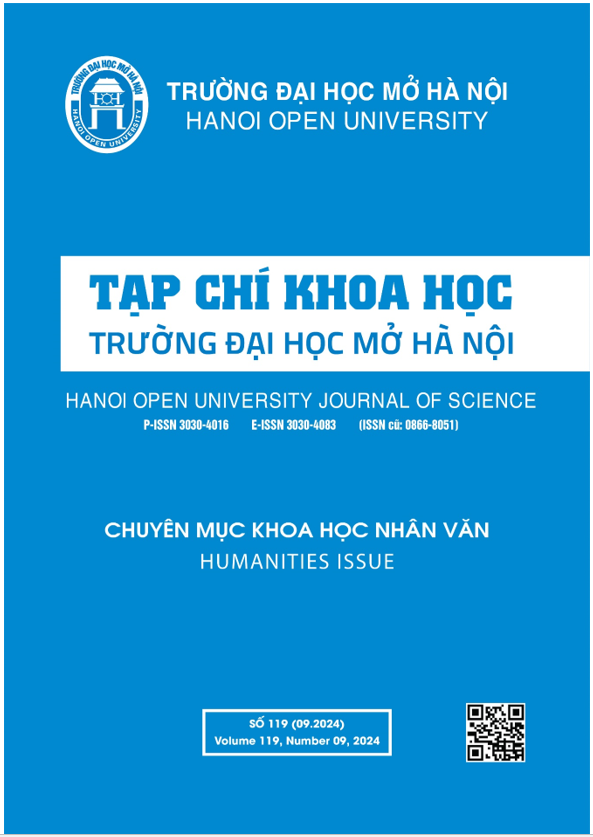ESCALATING THE EFFECTIVENESS OF THE ENGLISH TEACHING PROGRAM THROUGH BLENDED LEARNING: A CASE STUDY AT A SECONDARY SCHOOL
DOI:
https://doi.org/10.59266/houjs.2024.456Từ khóa:
Blended learning, teacher training, English teaching and learning, Learning management system, professional developmentTóm tắt
Since first mentioned in the EPIC learning workshop in 1999, Blended learning (BL) has become increasingly popular in the education industry, especially during Covid 2019. BL researchers how that when combining in-person classroom instruction with online and virtual components, the method can maximize the benefits of both and result in an enhancement of personalized teaching with the ease, flexibility, and accessibility of technology in many language teaching programs across the world (Adas & Bakir, 2013; Grgurovic, 2011; Ghazizadeh & Fatemipour, 2017). This research was carried out with 20 ESL teachers and 1000 students at a secondary school where there has been a solid shift to BL in the last two years. This paper introduces and discusses the process of building blended ELT courses at the school and how blended learning has benefitted the quality of the English teaching program. It points out that a blended learning ELT program was proved effective when: (i)The LMS lelessons; accordingly, ocused; (ii)Teachers were thoroughly trained about the BL model and knew how to plan the lessons accordingly; (iii) Teachers and program managers made use of LMS Quiz for formative and summative assessment, based on which teaching decisions were made and (iv) Teachers and students utilized coaching and tutoring practice and offered opportunities for feedback and reflection. The research will be of interest to schools and ELT departments looking for a measure to apply BL to improve the effectiveness of their programs and teachers wishing to better their teaching experience.
Tài liệu tham khảo
[1]. Adas, D., & Bakir, A. (2013). Writing difficulties and new solutions: blended learning as an approach to improve writing abilities. International Journal of Humanities and Social Science, 3(9), 254-266.
[2]. Dringus, L. P., & A. B. Seagull. (2015). A five-year study of sustaining blended learning initiatives to enhance academic engagement in computer and information sciences campus courses. In Blended learning: Research perspectives. Vol. 2. Edited by A.G. Picciano, C. D. Dziuban, and C.R. Graham, 122-140. New York: Routledge.
[3]. Dziuban, C., & Moskal, P. (2011). A course is a course: Factor invariance in student evaluation of online, blended, and face-to-face learning environments. The Internet and Higher Education, 14(4), 236-241.
[4]. Dziuban, C., Moskal, P., Hermsdorfer, A., DeSantis, G., Norberg, A., & Bradford, G., (2015) A deconstruction of blended learning. Presented at the 11th annual Sloan-C blended learning conference and workshop.
[5]. Dziuban, C., Picciano, A. G., Graham, C. R., & Moskal, P. D. (2016). Conducting research in online and blended learning environments: New pedagogical frontiers. New York: Routledge, Taylor & Francis Group.
[6]. Dziuban, C. D., Hartman, J. L., & Moskal, P. D. (2004). Blended learning. EDUCAUSE Research Bulletin, 7, 1-12.
[7]. Garrison, D. R., & Kanuka, H. (2004). Blended learning: Uncovering its transformative potential in higher education. The Internet and Higher Education, pp. 7, 95-105.
[8]. Ghazizadeh, T., & Fatemipour, H. (2017). The effect of blended learning on EFL learners’ reading proficiency. Journal of Language Teaching and Research, 8(3), 606-614. doi:10.17507/ jltr.0803.21.
[9]. Graham,C.R.(2013). Emergingpractice and research in blended learning. In M.
G. Moore (Ed.), Handbook of distance education, (3rd ed., pp. 333-350). New York: Routledge.
[10]. Grgurovic, M. (2011). Blended Learning in an ESL Class: A Case Study, CALICO Journal, v29 n1 p100- 117 Sep 2011.
[11]. Halverson, R., Grigg, J., Prichett, R. & Thomas, C. (2005b). The new instructional leadership: Creating data- driven instructional systems in schools. Wisconsin Center for Educational Research Working Paper, No. 2005-9. University of Wisconsin: Madison. Retrieved July 24, 2006, from http:// www.wcer.wisc.edu/publications/ workingPapers/Working_Paper_ No_2005_9.php
[12]. Means, B., Toyama, Y., Murphy, R., & Baki, M. (2013). The effectiveness of online and blended learning: A meta- analysis of empirical literature. Teachers College Record, 115(3), 1-47.
[13]. Moskal, P., Dziuban, C., & Hartman, J. (2013). Blended learning: A dangerous idea? The Internet and Higher Education, 18, 15-23.
[14]. Norberg, A., Dziuban, C. D., & Moskal, P. D. (2011). A time-based blended learning model. On the Horizon, 19(3), 207-216. https://doi. org/10.1108/10748121111163913.
[15]. Picciano, A. G. (2009). Blending with purpose: The multimodal model. Journal of Asynchronous Learning Networks, 13(1), 7-18.
[16]. Ross, B., & Gage, K. (2006). Global perspectives on blended learning: Insight from WebCT and our customers in higher education. In C. J. Bonk, &C. R. Graham (Eds.), Handbook of blended learning: Global perspectives, local designs, (pp. 155-168). San Francisco: Pfeiffer.
[17]. Rovai, A. P., & Jordan, H. M. (2004). Blended learning and sense of community: A comparative analysis with traditional and fully online graduate courses. International Review of Research in Open and Distance Learning, 5(2), 1-13.
[18]. Tynan, B., Ryan, Y., & Lamont- Mills, A. (2015). Examining workload models online and blended teaching. British Journal of Educational Technology, 46(1), 5-15.
